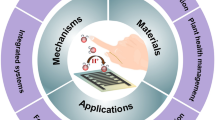Abstract
There is an increasing demand for materials that incorporate advanced adhesion properties, such as an ability to adhere in a reversible and controllable manner. In biological systems, these features are known from adhesive pads of the tree frog, Litoria caerulea, and the bush-cricket, Tettigonia viridissima. These species have convergently developed soft, hemispherically shaped pads that might be able to control their adhesion through active changing the curvature of the pad. Inspired by these biological systems, an artificial model system is developed here. It consists of an inflatable membrane clamped to the metallic cylinder and filled with air. Pull-off force measurements of the membrane surface were conducted in contact with the membrane at five different radii of curvature r c with (1) a smooth polyvinylsiloxane membrane and (2) mushroom-shaped adhesive microstructured membrane made of the same polymer. The hypothesis that an increased internal pressure, acting on the membrane, reduces the radius of the membrane curvature, resulting in turn in a lower pull-off force, is verified. Such an active control of adhesion, inspired by biological models, will lead to the development of industrial pick-and-drop devices with controllable adhesive properties.






Similar content being viewed by others
References
S.N. Gorb, Biological attachment devices: exploring nature’s diversity for biomimetics. Phil. Trans. R. Soc. A 336, 1557–1574 (2008)
S.N. Gorb, R.G. Beutel, E.V. Gorb, Y. Jiao, V. Kastner, S. Niederegger, V.L. Popov, M. Scherge, U. Schwarz, W. Vötsch, Structural design and biomechanics of friction-based releasable attachment devices in insects. Integr. Comp. Biol. 42, 1127–1139 (2002)
W.J.P. Barnes, Functional morphology and design constraints of smooth adhesive pads. MRS Bull. 32, 479–485 (2007)
M. Kamperman, E. Kroner, A. del Campo, R.M. McMeeking, E. Arzt, Functional adhesive surfaces with “gecko” effect: the concept of contact splitting. Adv. Eng. Mater. 12, 335–348 (2010)
H. Gao, X. Wang, H. Yao, S.N. Gorb, E. Arzt, Mechanics of hierarchical adhesion structures of geckos. Mech. Mat. 37, 275–285 (2005)
A.P. Russell, A contribution to the functional analysis of the foot of the tokay, Gekko gecko (Reptilia: Gekkonidae). J. Zool. 176, 437–476 (1975)
S. Niederegger, S.N. Gorb, Tarsal movements in flies during leg attachment and detachment on a smooth substrate. J. Insect Physiol. 49, 611–620 (2003)
W. Federle, E.L. Brainerd, T.A. McMahon, B. Hölldobler, Biomechanics of the movable pretarsal adhesive organ in ants and bees. Proc. Natl. Acad. Sci. USA 98, 6215–6220 (2001)
A.P. Russell, Integrative functional morphology of the gekkotan adhesive system (Reptilia: Gekkota). Intergr. Comp. Biol. 42, 1154–1163 (2002)
M. Varenberg, S.N. Gorb, Hexagonal surface micropattern for dry and wet friction. Adv. Mater. 21, 483–486 (2009)
W.J.P. Barnes, P.J.P. Goodwyn, M. Nokhbatolfoghahai, S.N. Gorb, Elastic modulus of tree frog adhesive toe pads. J. Comp. Physiol. A. 197, 969–978 (2011)
Z. Dai, S.N. Gorb, Contact mechanics of pad of grasshopper (Insecta: Orthoptera) by finite element methods. Chin. Sci. Bull. 54, 549–555 (2009)
M. Scherge, S.N. Gorb, Using biological principles to design MEMS. J. Micromech. Microeng. 10, 359–364 (2000)
W.J.P. Barnes, C. Oines, J.M. Smith, Whole animal measurements of shear and adhesive forces in adult tree frogs insights into underlying mechanisms of adhesion obtained from studying the effects of size and scale. J. Comp. Physiol. A. 192, 1179–1191 (2006)
B. Henning, Morphologie und Histologie der Tarsen von Tettigonia viridissima L (Orthoptera, Ensifera). Zoomorphology 79, 323–342 (1974)
S.N. Gorb, Y. Jiao, M. Scherge, Ultrastructural architecture and mechanical properties of attachment pads in Tettigonia viridissima (Orthoptera Tettigoniidae). J. Comp. Physiol. A. 186, 821–831 (2000)
Y. Jiao, S.N. Gorb, M. Scherge, Adhesion measured on the attachment pads of Tettigonia viridissima (Orthoptera, Insecta). J. Exp. Biol. 203, 1887–1895 (2000)
A. Peressadko, S.N. Gorb, When less is more experimental evidence for tenacity enhancement by division of contact area. J. Adhesion 80, 247–261 (2004)
A.E. Kovalev, S.N. Gorb, Charge contribution to the adhesion performance of polymeric microstructures. Tribol. Lett. 48, 103–109 (2012)
S.N. Gorb, M. Varenberg, A. Peressadko, J. Tuma, Biomimetic mushroom-shaped fibrillar adhesive microstructure. J. R. Soc. Interface 13, 271–275 (2007)
L. Heepe, A.E. Kovalev, M. Varenberg, J. Tuma, S.N. Gorb, First mushroom-shaped adhesive microstructure: a review. Theor. Appl. Mech. Lett. 2, 014008 (2012)
L. Heepe, S. Gorb, Biologically inspired mushroom-shaped adhesive microstructures. Annu. Rev. Mater. Res. 44, 14.1–14.31 (2014). doi:10.1146/annurev-matsci-062910-100458
E. Kroner, D.R. Paretkar, R.M. McMeeking, E. Arzt, Adhesion of flat and structured PDMS samples to spherical and flat probes: a comparative study. J. Adhesion 87, 447–465 (2011)
M. Varenberg, A. Peressadko, S.N. Gorb, S. Arzt, S. Mrotzek, Advanced testing of adhesion and friction with a microtribometer. Rev. Sci. Instrum. 77, 066105 (2006)
N. Nadermann, J. Ning, A. Jagota, C.-Y. Hui, Active switching of adhesion in a film-terminated fibrillar structure. Langmuir 26, 15464–15471 (2010)
H. Prahlad, R. Pelrine, S. Stanford, J. Marlow, R. Kornbluh. Electroadhesive robots—wall climbing robots enabled by a novel, robust, and electrically controllable adhesion technology. IEEE International Conference on Robotics and Automation 3028–3033, 2008
S. Reddy, E. Arzt, A. del Campo, Bioinspired surfaces with switchable adhesion. Adv. Mater. 19, 3833–3837 (2007)
M. Kamperman, A. Synytska, Switchable adhesion by chemical functionality and topography. J. Mater. Chem. 22, 19390–19401 (2012)
D. Paretkar, M. Kamperman, A.S. Schneider, D. Martina, C. Creton, E. Arzt, Bioinspired pressure actuated adhesive system. Mater. Sci. Eng. C 31, 1152–1159 (2011)
H.E. Jeong, M.K. Kwak, K.Y. Suh, Stretchable, adhesion-tunable dry adhesive by surface wrinkling. Langmuir 26, 2223–2226 (2010)
M. Varenberg, S.N. Gorb, Shearing of fibrillar adhesive microstructure: friction and shear-related changes in pull-off force. J. R. Soc. Interface 4, 721–725 (2007)
M.J. Vogel, P.H. Steen, Capillarity-based switchable adhesion. PNAS 107, 3377–3381 (2010)
Acknowledgments
Valuable discussions with Dr. Henrik Peisker and Dr. Alexander Kovalev on the experimental set-up and contact mechanics are acknowledged. This work was supported by the German Science Foundation (DFG, project C-10 SFB 677).
Author information
Authors and Affiliations
Corresponding author
Rights and permissions
About this article
Cite this article
Dening, K., Heepe, L., Afferrante, L. et al. Adhesion control by inflation: implications from biology to artificial attachment device. Appl. Phys. A 116, 567–573 (2014). https://doi.org/10.1007/s00339-014-8504-2
Received:
Accepted:
Published:
Issue Date:
DOI: https://doi.org/10.1007/s00339-014-8504-2




